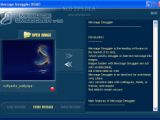Yes, you can pretend to be a Secret Agent with Message Smuggler
The way this program works is simple. You add your image file on the left window pane, and you add your text to the right pane. When you've added everything, you just encode it with a password and re-save the picture to something of your liking.
In the demo version of the program, every picture you save will have big red print over newly created image files with secret texts inside them, so don't get your hopes too high about the demo.
This is also the simplest interface I've used in a while. The dual paned GUI is easy enough for users of any level to use.
The encryption really works, they don't just add another layer to the picture. But there are some slight nuances that shouldn't be so easily overlooked.
Things to look for
I noticed that when I compared the 2 pictures' properties, the second (with the secret text) was significantly larger than the original. I guess that this shouldn't matter that much since the people who receive the image don't really know the original size of the file to begin with. There's one way to tell for sure if your picture was altered, and that's to know the picture's original properties.
What I was able to do was add a message over an image that already had a message on it. I can't tell if this is a good thing, or a bad thing. I'd imagine that if you write a text over an image that already has something written on it, you could potentially get rid of information you'd want to keep. I thought it was a bit odd that it asks you for a password when trying to open a secret text image, but it lets you go ahead and write over one without prompting for a password.
This makes sense if you don't already know that there's a secret text already there, but if you did know about it, there should be a way to warn the users that they are going to write over something that's already there.
Bond, James Bond
I guess it's not a new concept for hidden text messages to be transmitted through an ordinary picture file. The FBI and CIA have been doing it for years, and they've also been spying on people who have also been doing it for years. Well, this software's recently become more popular and available to the basic users who want to practice the arts of espionage.
Yes you too can now pull James Bond-like covert messages with Message Smuggler. This program works by 'smuggling' test messages into .JPG or .BMP files using a certified 256-bit encryption method. So you can send innocent looking pictures with a whole lot more behind them.
The Good
It's simple to use, and fun to play with. You have basic image support with Jpeg and Bitmap formats and the ability to add a whole lotta secret text to your image. You can compress the image and decompress it without the loss of the smuggled text.
The Bad
The bad part is that you only have JPEG and Bitmap formats available. You can also write over another person's text without knowing it. The files are noticeably different in size if you add a lot of text. Also, if you edit a picture after it's been encoded with the smuggled text, you lose the text.
The Truth
So the FBI and CIA thought they had a tough time with Skype, they'll have a little more on their hands now. Message Smuggler has good password protection and encryption. But with the demo version, it's almost worthless to get since the picture files you create have "Image contains hidden message" in big red bold letters written on it. It's still fun to try though.
Check out the pics below.
 14 DAY TRIAL //
14 DAY TRIAL // 





